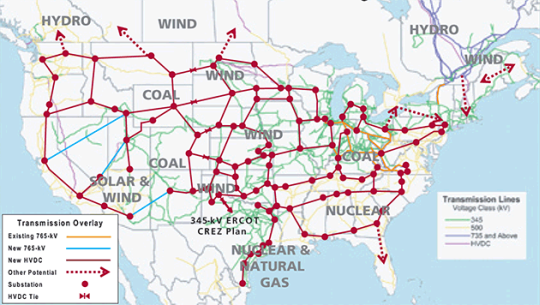Two years ago, nobody was talking about the nation’s electricity grid; today it’s so prominent in the national conversation that Barack Obama mentioned it in his inauguration speech. For energy wonk types, it’s pretty amazing.
Lots of politicians and pundits are sort of waving their hands toward the grid as an energy solution, without being very specific about their goals or the policies needed to get there. To add some clarity, it’s worth distinguishing two distinct grid issues, each with its own technological challenges, regulatory issues, and political implications.
To simplify matters, think of the grid like the nation’s waterways. There are a few big, primary rivers — the high-voltage, long-distance lines that compose the transmission system. Then there are thousands and thousands of smaller tributaries — the lower voltage lines that carry electricity from the transmission system to individual homes and businesses, called the distribution system. (I guess the homes and businesses are … lakes? Ponds? Frankly I haven’t thought the metaphor through that far.)
With that distinction in mind, we can discern two grid-related subjects of interest to energy/enviro types:
The National Grid
This has to do with extending the transmission system to address two problems:
- First, there aren’t many high-voltage lines that go to the places where renewable energy is most abundant (e.g., the Southwest for solar, the Midwest for wind).
- Second, right now there are (depending on how you count) anywhere from three to seven distinct regional grids that make up the national grid, and they aren’t very well connected. While juice circulates relatively freely within these grids, it’s difficult to get juice from one grid to another.
The wide grid refers to the effort to build a truly national transmission system: a new high-voltage backbone, with lines spanning the length and breadth of the country, able to carry electricity from anywhere it’s generated to anywhere it’s needed. Wide grid advocates argue that linking the entire nation together would mitigate the problem of intermittency — the fact that sun and wind are variable (as opposed to baseload sources that can be turned on and off at will). The more intermittent energy sources are linked together, the more stable and reliable the whole system becomes.
Some of the best work on the wide grid (from an unabashedly pro-expansionist viewpoint) has come out of the conservative Manhattan Institute. In particular, see Peter Huber’s report, The Million Volt Answer to Oil. (More here.) Here’s a map from MI that shows what a wide grid might look like:
You could also check out “Green Corridors: Linking Interregional Transmission Expansion and Renewable Energy Policies” from Resources for the Future.
The Smart Grid
This has to do with improving the intelligence and efficiency of both the distribution system and load — that is, the appliances, machines, and devices that consume electricity.
(The term itself is somewhat fuzzy; it’s not always clear what is and isn’t included.)
Today’s grid uses the same basic technology Edison used when he built the first grid back in the late 19th century. It is designed to take electricity “downhill” from central power stations to where it is used. Three problems with this.
- First, thanks to regulatory reforms that have introduced competition among power producers, electricity is often routed and rerouted between utility regions based on variable wholesale pricing and availability.
- Second, individuals and business can now produce their own power with rooftop solar panels, small-scale wind turbines, or combined heat and power systems — so-called distributed power production. Relative to the old model of large, far-off central station power plants, this new model is highly decentralized. Every node on the grid becomes both producer and consumer, and needs to be able to fluidly draw power from or feed power into the grid, on a real-time basis.
- Third, just over the horizon is a world in which thousands, possibly millions of plug-in hybrid or full-electric vehicles are connected to the grid, with batteries that serve as energy storage devices. (This is known as a vehicle-to-grid, or V2G system — Google is testing it out as we speak.) Each one of these vehicles will draw from the grid when it needs power and feed back into the grid during peak loads; they will be a massive, distributed storage system.
Each of these factors immensely complicates management of the grid. Smart grid advocates want to integrate information technology into the grid in various ways, from “smart meters” that can track residential or commercial electricity use in a real-time, fine-grained way to “smart appliances” that can respond automatically to load and pricing information to “smart buildings” that can coordinate energy use on a larger level. They also want more standardized rules, from state utility regulations allowing customers to feed electricity into the grid to software standards governing how smart meters and appliances communicate.
If you want to read more about smart grid issues you could do worse than “Building a National Clean-Energy Smart Grid” from Bracken Hendricks at the Center for American Progress. Also check out Patrick Mazza’s blogging, both here and at New Energy Nexus.
—-
This is all quite rudimentary and barely scratches the surface. The point is to sketch the basic lay of the land and get clear that one grid issue is getting more power (transmission lines to new places) and one is using power more efficiently (smarter distributions systems). The politics around those two issues are quite different, something we’ll be exploring more soon.



